
APOGEE INSTRUMENTS, INC. | 721 WEST 1800 NORTH, LOGAN, UTAH 84321, USA
TEL: (435) 792-4700 | FAX: (435) 787-8268 | WEB: APOGEEINSTRUMENTS.COM
Copyright © 2021 Apogee Instruments, Inc.
OWNER’S MANUAL
QUANTUM SENSOR
Models SQ-202X and SQ-205X
Rev: 1-Jun-2021

Owner’s Manual ............................................................................................................................................................................... 1
Certificate of Compliance ......................................................................................................................................................... 3
Introduction ............................................................................................................................................................................. 4
Sensor Models ......................................................................................................................................................................... 5
Specifications ........................................................................................................................................................................... 6
Deployment and Installation .................................................................................................................................................... 8
Cable Connectors ................................................................................................................................................................... 10
Operation and Measurement ................................................................................................................................................ 10
Maintenance and Recalibration ............................................................................................................................................. 15
Troubleshooting and Customer Support ................................................................................................................................ 17
Return and Warranty Policy ................................................................................................................................................... 18

CERTIFICATE OF COMPLIANCE
EU Declaration of Conformity
This declaration of conformity is issued under the sole responsibility of the manufacturer:
Apogee Instruments, Inc.
721 W 1800 N
Logan, Utah 84321
USA
for the following product(s):
Models: SQ-202X, SQ-205X
Type: Quantum Sensor
The object of the declaration described above is in conformity with the relevant Union harmonization legislation:
2014/30/EU Electromagnetic Compatibility (EMC) Directive
2011/65/EU Restriction of Hazardous Substances (RoHS 2) Directive
2015/863/EU Amending Annex II to Directive 2011/65/EU (RoHS 3)
Standards referenced during compliance assessment:
EN 61326-1:2013 Electrical equipment for measurement, control and laboratory use – EMC requirements
EN 50581:2012 Technical documentation for the assessment of electrical and electronic products with respect to
the restriction of hazardous substances
Please be advised that based on the information available to us from our raw material suppliers, the products
manufactured by us do not contain, as intentional additives, any of the restricted materials including lead (see
note below), mercury, cadmium, hexavalent chromium, polybrominated biphenyls (PBB), polybrominated
diphenyls (PBDE), bis(2-ethylhexyl) phthalate (DEHP), butyl benzyl phthalate (BBP), dibutyl phthalate (DBP), and
diisobutyl phthalate (DIBP). However, please note that articles containing greater than 0.1% lead concentration are
RoHS 3 compliant using exemption 6c.
Further note that Apogee Instruments does not specifically run any analysis on our raw materials or end products
for the presence of these substances, but rely on the information provided to us by our material suppliers.
Signed for and on behalf of:
Apogee Instruments, June 2021
Bruce Bugbee
President
Apogee Instruments, Inc.

INTRODUCTION
Radiation that drives photosynthesis is called photosynthetically active radiation (PAR) and is typically defined as
total radiation across a range of 400 to 700 nm. PAR is often expressed as photosynthetic photon flux density
(PPFD): photon flux in units of micromoles per square meter per second (µmol m-2 s-1, equal to microEinsteins per
square meter per second) summed from 400 to 700 nm (total number of photons from 400 to 700 nm). While
Einsteins and micromoles are equal (one Einstein = one mole of photons), the Einstein is not an SI unit, so
expressing PPFD as µmol m-2 s-1 is preferred.
The acronym PPF is also widely used and refers to the photosynthetic photon flux. The acronyms PPF and PPFD
refer to the same variable. The two terms have co-evolved because there is not a universal definition of the term
“flux”. Some physicists define flux as per unit area per unit time. Others define flux only as per unit time. We
have used PPFD in this manual because we feel that it is better to be more complete and possibly redundant.
Sensors that measure PPFD are often called quantum sensors due to the quantized nature of radiation. A quantum
refers to the minimum quantity of radiation, one photon, involved in physical interactions (e.g., absorption by
photosynthetic pigments). In other words, one photon is a single quantum of radiation.
Typical applications of quantum sensors include incoming PPFD measurement over plant canopies in outdoor
environments or in greenhouses and growth chambers, and reflected or under-canopy (transmitted) PPFD
measurement in the same environments.
Apogee Instruments SQ-100X series quantum sensors consist of a cast acrylic diffuser (filter), interference filter,
photodiode, and signal processing circuitry mounted in an anodized aluminum housing, and a cable to connect the
sensor to a measurement device. Sensors are potted solid with no internal air space, and are designed for
continuous PPFD measurement in indoor or outdoor environments. The voltage signal from the sensor is directly
proportional to radiation incident on a planar surface (does not have to be horizontal), where the radiation
emanates from all angles of a hemisphere.

SENSOR MODELS
This manual covers quantum sensor models SQ-202X and SQ-205X, which provide a voltage signal. Additional
models are covered in their respective manuals.
Model
Signal
SQ-202X
0-2.5 V
SQ-205X
0-5 V
SQ-100X
Self-powered
SQ-204X
4-20 mA
SQ-420X
USB
SQ-421X
SDI-12
SQ-422X
Modbus
Sensor model number and serial number are
located on the bottom of the sensor. If you need
the manufacturing date of your sensor, please
contact Apogee Instruments with the serial
number of your sensor.

SPECIFICATIONS
Calibration Traceability
Apogee SQX series quantum sensors are calibrated through side-by-side comparison to the mean of transfer
standard quantum sensors under a reference lamp. The reference quantum sensors are recalibrated with a 200 W
quartz halogen lamp traceable to the National Institute of Standards and Technology (NIST).
SQ-202X-SS
SQ-205X-SS
Power Supply
5 to 24 V DC; nominal current draw 300
µA
5.5 to 24 V DC**; nominal current draw 300 µA
**Sensors with a serial number smaller than
3762 should not be powered with more than 5
V DC
Sensitivity
1 mV per µmol m-2 s-1
2 mV per µmol m-2 s-1
Calibration Factor
(Reciprocal of Sensitivity)
1 µmol m-2 s-1 per mV
0.5 µmol m-2 s-1 per mV
Calibrated Output Range
0 to 2.5 V
0 to 5 V
Calibration Uncertainty
± 5 % (see Calibration Traceability below)
Measurement Repeatability
Less than 0.5 %
Long-term Drift
(Non-stability)
Less than 2 % per year
Non-linearity
Less than 1 % (up to 4000 µmol m-2 s-1)
Response Time
Less than 1 ms
Field of View
180°
Spectral Range
370 to 650 nm (wavelengths where response is greater than 50 % of maximum; see Spectral
Response below)
Directional (Cosine) Response
± 5 % at 75° zenith angle (see Cosine Response below)
Temperature Response
0.06 ± 0.06 % per C (see Temperature Response below)
Operating Environment
-40 to 70 C; 0 to 100 % relative humidity; can be submerged in water up to depths of 30 m
Dimensions
30.5 mm diameter, 37 mm height
Mass (with 5 m cable)
140 g
Cable
5 m of two conductor, shielded, twisted-pair wire; TPR jacket (high water resistance, high UV
stability, flexibility in cold conditions); pigtail lead wires; stainless steel (316), M8 connector

Spectral Response
Mean spectral response of four SQ-100x
series quantum sensors compared to PPFD
weighting function. Spectral response
measurements were made at 10 nm
increments across a wavelength range of
350 to 800 nm in a monochromator with an
attached electric light source. Measured
spectral data from each quantum sensor
were normalized by the measured spectral
response of the monochromator/electric
light combination, which was measured
with a spectroradiometer.

Cosine Response
Directional (cosine) response is defined as the
measurement error at a specific angle of
radiation incidence. Error for Apogee SQ-100x
series quantum sensors is approximately ± 2 %
and ± 5 % at solar zenith angles of 45° and 75°,
respectively.
Mean cosine response of five SQ-
100X series quantum sensors.
Cosine response measurements
were made by direct side-by-side
comparison to the mean of seven
reference SQ-500 quantum
sensors.

DEPLOYMENT AND INSTALLATION
Mount the sensor to a solid surface with the nylon mounting screw provided. To accurately measure PPFD incident
on a horizontal surface, the sensor must be level. An Apogee Instruments model AL-100 Leveling Plate is
recommended to level the sensor when used on a flat surface or being mounted to surfaces such as wood. To
facilitate mounting on a mast or pipe, the Apogee Instruments model AL-120 Solar Mounting Bracket with Leveling
Plate is recommended.
To minimize azimuth error, the sensor should be mounted with the cable pointing toward true north in the
northern hemisphere or true south in the southern hemisphere. Azimuth error is typically less than 1 %, but it is
easy to minimize by proper cable orientation.
In addition to orienting the cable to point toward the nearest pole, the sensor should also be mounted such that
obstructions (e.g., weather station tripod/tower or other instrumentation) do not shade the sensor. Once
mounted, the blue cap should be removed from the sensor. The blue cap can be used as a protective covering for
the sensor when it is not in use.
Nylon Screw: 10-32x3/8
Nylon Screw: 10-32x3/8
Model AL-100
Model AL-120
Important: Only use the nylon screw provided
when mounting to insulate the non-anodized
threads of the aluminum sensor head from the
base to help prevent galvanic corrosion. For
extended submersion applications, more insulation
may be necessary. Contact Apogee tech support for
details.

CABLE CONNECTORS
Apogee sensors offer cable connectors to simplify
the process of removing sensors from weather
stations for calibration (the entire cable does not
have to be removed from the station and shipped
with the sensor).
The ruggedized M8 connectors are rated IP68, made
of corrosion-resistant marine-grade stainless-steel,
and designed for extended use in harsh
environmental conditions.
Cable connectors are attached directly to the head.
Instructions
Pins and Wiring Colors: All Apogee
connectors have six pins, but not all pins are
used for every sensor. There may also be
unused wire colors inside the cable. To
simplify datalogger connection, we remove
the unused pigtail lead colors at the
datalogger end of the cable.
If a replacement cable is required, please
contact Apogee directly to ensure ordering
the proper pigtail configuration.
Alignment: When reconnecting a sensor,
arrows on the connector jacket and an
aligning notch ensure proper orientation.
Disconnection for extended periods: When
disconnecting the sensor for an extended
period of time from a station, protect the
remaining half of the connector still on the
station from water and dirt with electrical
tape or other method.
A reference notch inside the connector ensures
proper alignment before tightening.
When sending sensors in for calibration, only send the sensor head.
Tightening: Connectors are designed to be
firmly finger-tightened only. There is an o-
ring inside the connector that can be overly
compressed if a wrench is used. Pay
attention to thread alignment to avoid
cross-threading. When fully tightened, 1-2
threads may still be visible.
WARNING: Do not tighten the connector by
twisting the black cable or sensor head, only
twist the metal connector (blue arrows).
Finger-tighten firmly

OPERATION AND MEASUREMENT
Connect the sensor to a measurement device (meter, datalogger, controller) capable of measuring and displaying
or recording a voltage signal with a range of 0-2.5 V (SQ-202X) or 0-5 V (SQ-205X) to cover the entire range of PPFD
from the sun. In order to maximize the measurement resolution and signal-to-noise ratio, the signal input range of
the measurement device should closely match the output range of the quantum sensors. The amplification circuit
requires a power supply of 2.5-24 VDC (SQ-202X) or 5-24 VDC (SQ-205X). NOTE: To prevent sensor damage, DO
NOT connect the sensor to a power source greater than 24 VDC.
Wiring for SQ-202X and SQ-205X
White: Positive (signal from sensor)
Red: Input Power SQ-212X 3.3-24 V DC, SQ-215X 5.5-24 V DC
Black: Ground (from sensor signal and output power)
Clear: Shield/Ground

Sensor Calibration
Amplified quantum sensor models have a standard PPFD calibration factor of exactly:
SQ-202X: 1.6 µmol m-2 s-1 per mV
SQ-205X: 0.8 µmol m-2 s-1 per mV
Multiply this calibration factor by the measured mV signal to convert sensor output to PPFD in units of µmol m-2 s-1:
Calibration Factor (0.8 µmol m-2 s-1 per mV) * Sensor Output Signal (mV) = PPFD (µmol m-2 s-1)
0.8 * 2500 = 2000
Full Sunlight
(2000 µmol m-2 s-1)
Sensor Output: 4 V
Conversion Factor: 0.5 µmol m-2 s-1 per mV
Sensor Output: 2 V
Conversion Factor: 1.0 µmol m-2 s-1 per mV
SQ-215/225
SQ-212-222
Sensor Output: 2.5 V
Conversion Factor: 0.8 µmol m-2 s-1 per mV
Sensor Output: 1.25 V
Conversion Factor: 1.6 µmol m-2 s-1 per mV
Example of PPFD measurement with an Apogee quantum sensor. Full
sunlight yields a PPFD on a horizontal plane at the Earth’s surface of
approximately 2000 µmol m-2 s-1. This yields an output signal of 2500 mV
for the 0-5 V option or an output signal of 1250 mV for the 0-2.5 V
option. The signal is converted to PPFD by multiplying by the calibration
factor.
SQ-205X
SQ-202X

Spectral Errors
Apogee SQ-100X series sensors can measure PPFD for sunlight and electric light with a single calibration factor.
However, errors occur in various light sources due to changes in spectral output. If the light source spectrum is
known then errors can be estimated and used to adjust the measurements. The weighting function for PPFD is
shown in the graph below, along with the spectral response of Apogee SQ-100X series quantum sensors. The closer
the spectral response matches the defined PPFD spectral weighting functions, the smaller spectral errors will be.
The table below provides spectral error estimates for PPFD measurements from light sources different than the
calibration source. The method of Federer and Tanner (1966) was used to determine spectral errors based on the
PPFD spectral weighting functions, measured sensor spectral response, and radiation source spectral outputs
(measured with a spectroradiometer). This method calculates spectral error and does not consider calibration,
cosine, and temperature errors.
Federer, C. A., and C. B. Tanner, 1966. Sensors for measuring light available for photosynthesis. Ecology 47:654-
657.
McCree, K. J., 1972. The action spectrum, absorptance and quantum yield of photosynthesis in crop plants.
Agricultural Meteorology 9:191-216.

Spectral Errors for PPFD and YPFD Measurements with Apogee SQ-100X Series Quantum Sensors
Radiation Source (Error Calculated Relative to Sun, Clear Sky)
PPFD Error [%]
Sun (Clear Sky)
0.0
Sun (Cloudy Sky)
0.2
Reflected from Grass Canopy
5.0
Reflected from Deciduous Canopy
7.0
Reflected from Conifer Canopy
7.3
Transmitted below Grass Canopy
8.3
Transmitted below Deciduous Canopy
8.4
Transmitted below Conifer Canopy
10.1
Cool White Fluorescent (T5)
7.2
Cool White Fluorescent (T12)
8.3
Metal Halide
6.9
Ceramic Metal Halide
-0.9
High Pressure Sodium
3.2
Blue LED (448 nm peak, 20 nm full-width half-maximum)
14.5
Green LED (524 nm peak, 30 nm full-width half-maximum)
29.6
Red LED (635 nm peak, 20 nm full-width half-maximum)
-30.9
Red, Blue LED Mixture (80 % Red, 20 % Blue)
-21.2
Red, Green, Blue LED Mixture (70 % Red, 15 % Green, 15 % Blue)
-16.4
Cool White Fluorescent LED
7.3
Neutral White Fluorescent LED
1.1
Warm White Fluorescent LED
-7.8
Quantum sensors can be a very practical means of measuring PPFD and YPFD from multiple radiation sources, but
spectral errors must be considered. The spectral errors in the table above can be used as correction factors for
individual radiation sources.
Underwater Measurements and Immersion Effect
When a quantum sensor that was calibrated in air is used to make underwater measurements, the sensor reads
low. This phenomenon is called the immersion effect and happens because the refractive index of water (1.33) is
greater than air (1.00). The higher refractive index of water causes more light to be backscattered (or reflected)
out of the sensor in water than in air (Smith,1969; Tyler and Smith,1970). As more light is reflected, less light is
transmitted through the diffuser to the detector, which causes the sensor to read low. Without correcting for this
effect, underwater measurements are only relative, which makes it difficult to compare light in different
environments.
The SQ-100X series sensors have an immersion effect correction factor of 1.15. This correction factor should be
multiplied to measurements made underwater.
Further information on underwater measurements and the immersion effect can be found at
http://www.apogeeinstruments.com/underwater-par-measurements/.

MAINTENANCE AND RECALIBRATION
Blocking of the optical path between the target and detector can cause low readings. Occasionally, accumulated
materials on the diffuser of the sensor can block the optical path in three common ways:
1. Moisture or debris on the diffuser.
2. Dust during periods of low rainfall.
3. Salt deposit accumulation from evaporation of sea spray or sprinkler irrigation water.
Apogee Instruments quantum sensors have a domed diffuser and housing for improved self-cleaning from rainfall,
but active cleaning may be necessary. Dust or organic deposits are best removed using water, or window cleaner,
and a soft cloth or cotton swab. Salt deposits should be dissolved with vinegar and removed with a cloth or cotton
swab. Salt deposits cannot be removed with solvents such as alcohol or acetone. Use only gentle pressure when
cleaning the diffuser with a cotton swab or soft cloth to avoid scratching the outer surface. The solvent should be
allowed to do the cleaning, not mechanical force. Never use abrasive material or cleaner on the diffuser.
Although Apogee sensors are very stable, nominal calibration drift is normal for all research-grade sensors. To
ensure maximum accuracy, recalibration every two years is recommended. Longer time periods between
recalibration may be warranted depending on tolerances. See the Apogee webpage for details regarding return of
sensors for recalibration (http://www.apogeeinstruments.com/tech-support-recalibration-repairs/).
To determine if your sensor needs recalibration, the Clear Sky Calculator (www.clearskycalculator.com) website
and/or smartphone app can be used to indicate the PPFD incident on a horizontal surface at any time of day at any
location in the world. It is most accurate when used near solar noon in spring and summer months, where
accuracy over multiple clear and unpolluted days is estimated to be ± 4 % in all climates and locations around the
world. For best accuracy, the sky must be completely clear, as reflected light from clouds causes PPFD to increase
above the value predicted by the clear sky calculator. Measured values of PPFD can exceed values predicted by the
Clear Sky Calculator due to reflection from thin, high clouds and edges of clouds, which enhances incoming PPFD.
The influence of high clouds typically shows up as spikes above clear sky values, not a constant offset greater than
clear sky values.
To determine recalibration need, input site conditions into the calculator and compare PPFD measurements to
calculated values for a clear sky. If sensor PPFD measurements over multiple days near solar noon are consistently
different than calculated values (by more than 6 %), the sensor should be cleaned and re-leveled. If measurements
are still different after a second test, email calibration@apogeeinstruments.com to discuss test results and
possible return of sensor(s).

Homepage of the Clear Sky
Calculator. Two calculators are
available: one for quantum
sensors (PPFD) and one for
pyranometers (total shortwave
radiation).
Clear Sky Calculator for
quantum sensors. Site data are
input in blue cells in middle of
page and an estimate of PPFD is
returned on right-hand side of
page.

TROUBLESHOOTING AND CUSTOMER SUPPORT
Independent Verification of Functionality
Apogee SQ-200X series quantum sensors provide an amplified voltage output that is proportional to incident PPFD.
A quick and easy check of sensor functionality can be determined using a DC power supply and a voltmeter. Power
the sensor with a DC voltage by connecting the positive voltage signal to the red wire from the sensor and the
negative (or common) to the black wire from the sensor. Use the voltmeter to measure across the white wire
(output signal) and black wire. Direct the sensor head toward a light source and verify the sensor provides a signal.
Increase and decrease the distance from the sensor head to the light source to verify that the signal changes
proportionally (decreasing signal with increasing distance and increasing signal with decreasing distance). Blocking
all radiation from the sensor should force the sensor signal to zero.
Compatible Measurement Devices (Dataloggers/Controllers/Meters)
SQ-200X series quantum sensors are calibrated with a standard calibration factor of 1.6 µmol m-2 s-1 per mV (SQ-
212X) or 0.8 µmol m-2 s-1 per mV (SQ-215X), yielding a sensitivity of 0.6 mV per µmol m-2 s-1 (SQ-212X) or 1.25 mV
per µmol m-2 s-1 (SQ-215X). Thus, a compatible measurement device (e.g., datalogger or controller) should have
resolution of at least 0.6 mV to provide PPFD resolution of 1 µmol m-2 s-1.
Cable Length
When the sensor is connected to a measurement device with high input impedance, sensor output signals are not
changed by shortening the cable or splicing on additional cable in the field. Tests have shown that if the input
impedance of the measurements device is greater than 1 mega-ohm there is negligible effect on the calibration,
even after adding up to 100 m of cable. All Apogee sensors use shielded, twisted pair cable to minimize
electromagnetic interference. For best measurements, the shield wire must be connected to an earth ground. This
is particularly important when using the sensor with long lead lengths in electromagnetically noisy environments.
Modifying Cable Length:
See Apogee webpage for details on how to extend sensor cable length:
(http://www.apogeeinstruments.com/how-to-make-a-weatherproof-cable-splice/).
Unit Conversion Charts
Apogee SQX series quantum sensors are calibrated to measure PPFD in units of µmol m-2 s-1. Units other than
photon flux density (e.g., energy flux density, illuminance) may be required for certain applications. It is possible to
convert the PPFD value from a quantum sensor to other units, but it requires spectral output of the radiation
source of interest. Conversion factors for common radiation sources can be found on the Unit Conversions page in
the Support Center on the Apogee website (http://www.apogeeinstruments.com/unit-conversions/; scroll down to
Quantum Sensors section). A spreadsheet to convert PPFD to energy flux density or illuminance is also provided in
the Unit Conversions page in the Support Center on the Apogee website
(http://www.apogeeinstruments.com/content/PPFD-to-Illuminance-Calculator.xls).

RETURN AND WARRANTY POLICY
RETURN POLICY
Apogee Instruments will accept returns within 30 days of purchase as long as the product is in new condition (to be
determined by Apogee). Returns are subject to a 10 % restocking fee.
WARRANTY POLICY
What is Covered
All products manufactured by Apogee Instruments are warranted to be free from defects in materials and craftsmanship
for a period of four (4) years from the date of shipment from our factory. To be considered for warranty coverage an
item must be evaluated by Apogee.
Products not manufactured by Apogee (spectroradiometers, chlorophyll content meters, EE08-SS probes) are covered
for a period of one (1) year.
What is Not Covered
The customer is responsible for all costs associated with the removal, reinstallation, and shipping of suspected warranty
items to our factory.
The warranty does not cover equipment that has been damaged due to the following conditions:
1. Improper installation or abuse.
2. Operation of the instrument outside of its specified operating range.
3. Natural occurrences such as lightning, fire, etc.
4. Unauthorized modification.
5. Improper or unauthorized repair.
Please note that nominal accuracy drift is normal over time. Routine recalibration of sensors/meters is considered part of
proper maintenance and is not covered under warranty.
Who is Covered
This warranty covers the original purchaser of the product or other party who may own it during the warranty period.
What Apogee Will Do
At no charge Apogee will:
1. Either repair or replace (at our discretion) the item under warranty.
2. Ship the item back to the customer by the carrier of our choice.
Different or expedited shipping methods will be at the customer’s expense.
How To Return An Item
1. Please do not send any products back to Apogee Instruments until you have received a Return Merchandise

APOGEE INSTRUMENTS, INC. | 721 WEST 1800 NORTH, LOGAN, UTAH 84321, USA
TEL: (435) 792-4700 | FAX: (435) 787-8268 | WEB: APOGEEINSTRUMENTS.COM
Copyright © 2021 Apogee Instruments, Inc.
Authorization (RMA) number from our technical support department by submitting an online RMA form at
www.apogeeinstruments.com/tech-support-recalibration-repairs/. We will use your RMA number for tracking of the
service item. Call (435) 245-8012 or email techsupport@apogeeinstruments.com with questions.
2. For warranty evaluations, send all RMA sensors and meters back in the following condition: Clean the sensor’s exterior
and cord. Do not modify the sensors or wires, including splicing, cutting wire leads, etc. If a connector has been attached
to the cable end, please include the mating connector – otherwise the sensor connector will be removed in order to
complete the repair/recalibration. Note: When sending back sensors for routine calibration that have Apogee’s standard
stainless-steel connectors, you only need to send the sensor with the 30 cm section of cable and one-half of the
connector. We have mating connectors at our factory that can be used for calibrating the sensor.
3. Please write the RMA number on the outside of the shipping container.
4. Return the item with freight pre-paid and fully insured to our factory address shown below. We are not responsible for
any costs associated with the transportation of products across international borders.
Apogee Instruments, Inc.
721 West 1800 North Logan, UT
84321, USA
5. Upon receipt, Apogee Instruments will determine the cause of failure. If the product is found to be defective in terms
of operation to the published specifications due to a failure of product materials or craftsmanship, Apogee Instruments
will repair or replace the items free of charge. If it is determined that your product is not covered under warranty, you
will be informed and given an estimated repair/replacement cost.
PRODUCTS BEYOND THE WARRANTY PERIOD
For issues with sensors beyond the warranty period, please contact Apogee at techsupport@apogeeinstruments.com to
discuss repair or replacement options.
OTHER TERMS
The available remedy of defects under this warranty is for the repair or replacement of the original product, and Apogee
Instruments is not responsible for any direct, indirect, incidental, or consequential damages, including but not limited to
loss of income, loss of revenue, loss of profit, loss of data, loss of wages, loss of time, loss of sales, accruement of debts
or expenses, injury to personal property, or injury to any person or any other type of damage or loss.
This limited warranty and any disputes arising out of or in connection with this limited warranty ("Disputes") shall be
governed by the laws of the State of Utah, USA, excluding conflicts of law principles and excluding the Convention for the
International Sale of Goods. The courts located in the State of Utah, USA, shall have exclusive jurisdiction over any
Disputes.
This limited warranty gives you specific legal rights, and you may also have other rights, which vary from state to state
and jurisdiction to jurisdiction, and which shall not be affected by this limited warranty. This warranty extends only to
you and cannot by transferred or assigned. If any provision of this limited warranty is unlawful, void or unenforceable,
that provision shall be deemed severable and shall not affect any remaining provisions. In case of any inconsistency
between the English and other versions of this limited warranty, the English version shall prevail.
This warranty cannot be changed, assumed, or amended by any other person or agreement.
-
 1
1
-
 2
2
-
 3
3
-
 4
4
-
 5
5
-
 6
6
-
 7
7
-
 8
8
-
 9
9
-
 10
10
-
 11
11
-
 12
12
-
 13
13
-
 14
14
-
 15
15
-
 16
16
-
 17
17
-
 18
18
-
 19
19
Apogee SQ-202X-SS Owner's manual
- Type
- Owner's manual
- This manual is also suitable for
Ask a question and I''ll find the answer in the document
Finding information in a document is now easier with AI
Related papers
-
Apogee SQ-610 EPAR SENSOR Owner's manual
-
Apogee SQ-622 Owner's manual
-
Apogee SQ-614 Owner's manual
-
Apogee SQ-100 User manual
-
Apogee MQ-510 Owner's manual
-
Apogee SQ-214 QUANTUM SENSOR Owner's manual
-
Apogee SQ-520 Owner's manual
-
Apogee MQ-301 Owner's manual
-
Apogee MQ-510 UNDER WATER QUANTUM METER Owner's manual
-
Apogee SQ-614 Owner's manual
Other documents
-
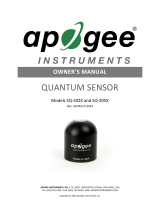 apogee INSTRUMENTS SQ-202X-SS Owner's manual
apogee INSTRUMENTS SQ-202X-SS Owner's manual
-
apogee INSTRUMENT SQ-100X Series Owner's manual
-
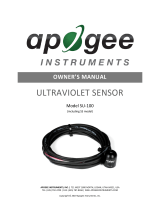 apogee INSTRUMENTS SU-220 Owner's manual
apogee INSTRUMENTS SU-220 Owner's manual
-
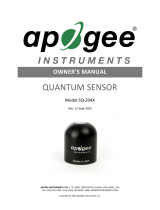 apogee INSTRUMENTS SQ-204X-SS Owner's manual
apogee INSTRUMENTS SQ-204X-SS Owner's manual
-
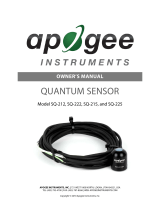 apogee INSTRUMENTS SQ-222-SS Owner's manual
apogee INSTRUMENTS SQ-222-SS Owner's manual
-
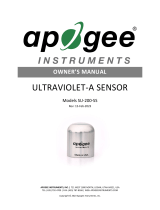 apogee INSTRUMENTS SU-200-SS Owner's manual
apogee INSTRUMENTS SU-200-SS Owner's manual
-
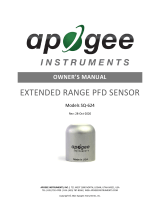 apogee INSTRUMENTS SQ-624-SS Owner's manual
apogee INSTRUMENTS SQ-624-SS Owner's manual
-
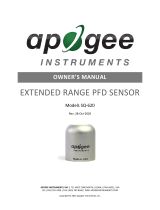 apogee INSTRUMENTS SQ-620 Owner's manual
apogee INSTRUMENTS SQ-620 Owner's manual
-
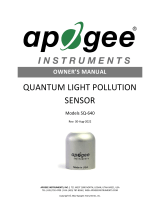 apogee INSTRUMENTS SQ-640-SS Owner's manual
apogee INSTRUMENTS SQ-640-SS Owner's manual
-
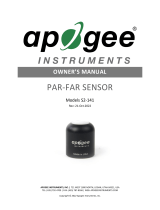 apogee INSTRUMENTS S2-141-SS Owner's manual
apogee INSTRUMENTS S2-141-SS Owner's manual



























